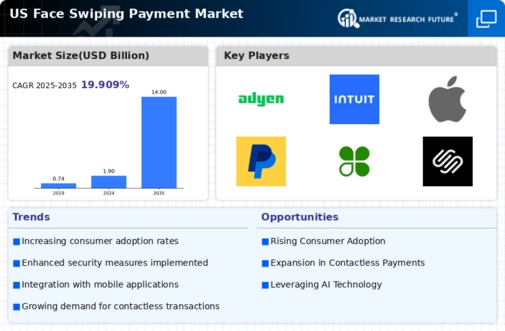Increased Focus on Customer Experience
In the face swiping-payment market, there is a growing emphasis on enhancing customer experience. Businesses are increasingly recognizing that seamless payment processes can significantly influence consumer satisfaction and loyalty. The integration of face swiping technology allows for faster transactions, reducing wait times at checkout. Research indicates that 70% of consumers are more likely to return to a store that offers efficient payment options. This focus on customer experience is driving retailers to adopt face swiping payment systems, as they seek to differentiate themselves in a competitive market. Moreover, the ability to personalize offers and promotions through facial recognition can further enhance the shopping experience. As businesses prioritize customer-centric strategies, the face swiping-payment market is expected to thrive, with companies investing in technologies that streamline payment processes and improve overall service quality.
Rising Demand for Contactless Payments
The face swiping-payment market is benefiting from the rising demand for contactless payment solutions. As consumers increasingly prefer quick and hygienic payment methods, the adoption of face swiping technology is on the rise. Recent statistics indicate that contactless payments accounted for approximately 40% of all transactions in the US in 2025. This shift towards contactless solutions is driven by convenience and speed, as consumers seek to minimize physical contact during transactions. Retailers and service providers are responding by integrating face swiping payment systems into their operations, enhancing customer satisfaction. The face swiping-payment market is likely to see continued growth as more businesses adopt these technologies to meet consumer preferences. Additionally, the convenience of face swiping payments aligns with the broader trend of digital transformation in the retail sector, further propelling the market forward.
Growing Investment in Fintech Solutions
The face swiping-payment market is witnessing a surge in investment in fintech solutions, which is driving innovation and adoption. Venture capital funding for fintech startups has reached unprecedented levels, with investments exceeding $50 billion in 2025. This influx of capital is enabling the development of advanced payment technologies, including face swiping systems. As fintech companies focus on creating user-friendly and secure payment solutions, the face swiping-payment market is likely to benefit from these innovations. Additionally, partnerships between traditional financial institutions and fintech firms are fostering the integration of face swiping technology into existing payment infrastructures. This collaborative approach is expected to enhance the overall efficiency and security of payment systems. As investment in fintech continues to grow, the face swiping-payment market is poised for significant expansion, driven by the demand for cutting-edge payment solutions.
Regulatory Support for Digital Payments
Regulatory support for digital payment solutions positively influences the face swiping-payment market. Government initiatives aimed at promoting cashless transactions are creating a favorable environment for the adoption of face swiping technology. Recent legislation has encouraged the development of secure payment systems, which aligns with the growing trend of digitalization in the financial sector. As regulations evolve to support innovative payment methods, businesses are more inclined to invest in face swiping payment systems. This regulatory backing not only enhances consumer trust but also encourages competition among payment service providers. Consequently, the face swiping-payment market is likely to expand as more companies enter the space, driven by the supportive regulatory landscape. The collaboration between government entities and private sector players is essential for fostering innovation and ensuring the security of digital payment systems.
Technological Advancements in Biometrics
The face swiping-payment market is experiencing a surge due to rapid advancements in biometric technology. Innovations in facial recognition algorithms and hardware have significantly improved the accuracy and speed of transactions. According to recent data, the biometric payment segment is projected to grow at a CAGR of 20% through 2027. This growth is driven by the increasing demand for secure and efficient payment methods. As consumers become more aware of the benefits of biometric authentication, the face swiping-payment market is likely to expand. Enhanced user experience and reduced transaction times are key factors contributing to this trend. Furthermore, the integration of artificial intelligence in biometric systems is expected to enhance security features, making face swiping payments more appealing to both consumers and businesses. Thus, technological advancements in biometrics are a crucial driver for the face swiping-payment market.

















Leave a Comment